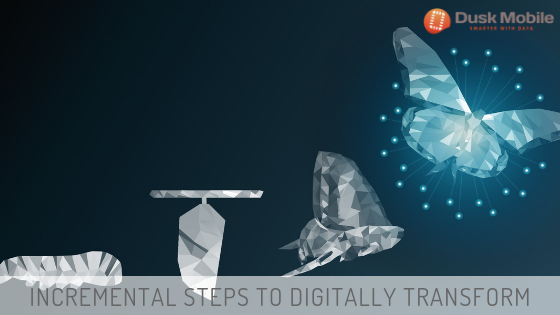
5 tips for incrementally digitally enabling your business
The term “digital transformation” has been around for a few years now and for a while was the phrase to show that your organisation was adapting to the changing way of doing business. During that time, successes have been aplenty but failures also. Failures are much less documented and uncovered during conversations in our experience, rather than press releases. Furthermore, failure is term carefully used so as not to create a fear of trying, in the environment of needed change.
This leads us to the mantra that digital transformation is a journey rather than a destination, therefore how should this journey be undertaken? Should a new business unit be created with comprising teams that have near full autonomy, as the express train service for implementing change? Or should the stopping all stations approach of Business as Usual (BAU) continue to be used? Both approaches have worked and will continue to work.
1. The Big Bang or Phased approach?
An observation we’ve noticed over the last 12+ months is organisations that have dipped their toe in digital transformation but not really embraced it, are more likely to be the same organisations trying to opt for a “big bang” digital transformation the second or third time around. We see this in part based on being left behind their industry peers or competitors and also when fresh blood arrives to transform. The risk here is not addressing the initial cause for only dipping the toe in to the digital transformation journey. Perhaps there are cultural issues, executive buy in, change management, fear of job security or any other underlying issues holding back progress.
Getting to the root cause should be prioritised. In some cases, scars can be fresh and benefit from a change in approach. This is where we see incremental change or a phased approach being of benefit. Typically, the opposite to the approach being used.
It is important to acknowledge that a Big Bang approach can and does work, in the right environment.
2. An ERP strategy is not a digital transformation alone
A regular theme we see is the need to define a core system strategy first, such as your ERP, EAM or CRM. We have read this being considered the actual digital transformation in some cases…. A core system strategy can be a crucial part of a technology strategy, feeding a digital transformation journey but is just that, a part.
The challenge faced with building the digital transformation around the core system selection process, runs the risk of holding back on getting started, for at least 12 months and in some cases several years if implementation is factored in. CIO’s don’t want to invest in what will be legacy infrastructure, duplicate change management effort and create greater technical debt amongst a host of other costs.
However, finding a balance with momentum is crucial in today’s competitive business landscape. There is also data strategy, which has been borne from the acceptance that data is considered a core asset, not a byproduct any longer. A data strategy has potentially similar implications to a core system strategy with delays but in our experience, this is easier to define and therefore progress to the digital transformation journey.
To address this, we see measured growth from business units in tandem with IT business partners exploring solutions that meet key architectural principles, user requirements and comply with security. These founding guidelines may already have been defined and enable the journey to start for processes or business units.
3. Change Management
Your employees have to be ready for change. They need the mental and physical tools to do so. A culture of embracing change should be established with open dialogue. Engaging Subject Matter Experts (SME’s) who have the knowledge and the respect of their peers. A collaborative approach leads to the most successful outcomes.
This is much easier to do in incremental stages. This may be a longer approach but done right, it creates a ground swell of change momentum and change champions.
A quote from Eddie Smith, Director of Operations at Kuhn Krause: “You can’t feed steak to a baby. You have to transition them from milk to steak over time.”
4. Working in the business
You’ll likely work with System Integrators and other vendors through the digital transformation journey. They bring expertise in delivering elsewhere, out of the box agility and serve as an extension of your team. The issue arises when these hired third parties are segregated from the very business units and processes, they are digital transforming. This is very common.
To solve this, your system integrators and vendors need to be working within the business units, building relationships and trust, understanding pain and looking at opportunities. Communicating every day with the same people they are transforming the work of. This may sound obvious but many teams are seated in a co-location due to seating issues or even remotely or even offshore. Yes, video conferencing goes some way to address this and can work in small doses but being there in person to understand the nuances of your teams is where the value is.
The cherry on the cake is depth of industry expertise. Bringing on a team who have delivered digitally before is good but a team that has delivered digitally and has the industry experience, is great.
5. Product & Process
Garbage in garbage out or derivatives of it are true. Digital transformation is the prime opportunity to review processes. Often reviewing or changing processes has been factored in to build a positive business case any way. Tackling your process optimisation in incremental steps ensures dependent processes, projects, customers or suppliers don’t hold up the overall digital transformation journey. The full benefit may not be realized in one hit but bringing each team along and the learnings from that, reduces risk and increases the likelihood of achieving objectives.
When it comes to the technology component of digital transformation, unfortunately this is where progress can he hampered. Do you have a product that supports incremental change? Many enterprise cloud based products on the market are built using well defined technology stacks but if your business has some specific process traits, product customisation is a costly and risky affair. Exactly the technical debt your CIO is concerned about! Conversely trying to shoehorn your process into the product is not a recipe for success. To resolve this, rather than look at every process that is touched, digitally transform individual processes. Does your “to-be” process fit the product?
One point that remains a standout clear recipe for success is, digital transformation must be driven top down. If the Executive team are not on board, the likelihood of success is very very low.
References
Digital Transformation Strategy – 7 Pieces
Digital Transformation is taking over should you be worried?
Takeaway Tip
So how do you get started? Speak to the team at Dusk about their experience in delivering incremental change as part of holistic digital transformation programs. Connect to your existing systems to create an all of contract view that can be shared between all parties.
The Dusk Mobile Intelligent Operations Platform connects your staff on any device, any time and in any location. Integrate your favourite products quickly and easily for real time collaboration amongst your teams. Automating work functions and delivering a connected experience has never been easier and achieving productivity improvements can start tomorrow.
If you’d like to find out more on visibility, consistent messaging, workflows, automation with project management and easy integration for your teams or business, get in touch today with our friendly team.
Any questions: Our community is here to help in the Support & Updates area!
Try a 14 day free trial of our Intelligent Operations Platform and start seeing the benefits of automated workflows, informed decision making and a single, comprehensive view of your business in real time. Start collaborating today.
Start your free trial today
Not sure where to start? Request a demo from our team via the link:
Request a Demo
Or you just have some questions:



